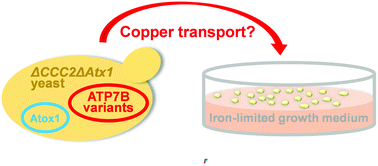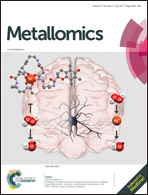Probing functional roles of Wilson disease protein (ATP7B) copper-binding domains in yeast†
Abstract
After Ctr1-mediated uptake into human cells, copper (Cu) ions are transported by the cytoplasmic Cu chaperone Atox1 to the Wilson disease protein (ATP7B) in the Golgi network. Cu transfer occurs via direct protein–protein interactions and leads to incorporation of Cu into Cu-dependent enzymes. ATP7B is a large multi-domain membrane-spanning protein which, in contrast to homologs, has six cytoplasmic metal-binding domains (MBDs). The reason for multiple MBDs is proposed to be indirect modulation of activity but mechanistic studies of full-length ATP7B are limited. We here developed a system that probes Cu flow through human Atox1 and ATP7B proteins when expressed in yeast. Using this assay, we assessed the roles of the different MBDs in ATP7B and found that the presence of the most N-terminal MBD increased, whereas the third MBD decreased, overall ATP7B-mediated Cu transport activity. Upon removal of all MBDs in ATP7B, the ability to transport Cu disappeared. The designed system can be expanded to include other yeast viability parameters and will be a useful tool for further mechanistic insights on human Cu transport as well as diseases involving Cu imbalance.



 Please wait while we load your content...
Please wait while we load your content...